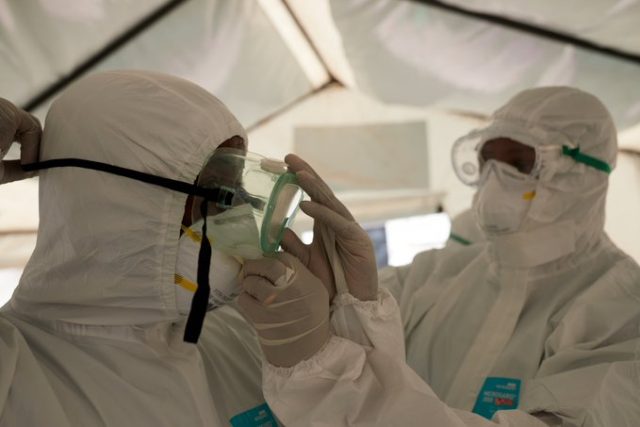Early detection of any disease is the goal for health workers in the Delta
FRI, AUG 14 2020-theG&BJournal-In many countries, tackling the COVID-19 pandemic has taken cues from other disease approaches, such as lessons from protecting communities against Ebola. But in Nigeria’s Niger Delta, health workers have found inspiration from guarding against the coronavirus.
They have exploited the rigorous surveillance standard set by the COVID-19 response to keep from losing sight of other priority diseases. Mostly what they have learned is how not to divide their attention.
The unifying surveillance strategy they have enveloped is quickly producing significant and – possibly oddly – uplifting results.
“I recorded my first acute flaccid paralysis case since last year while I was following up on the contact of a confirmed case of COVID-19,” says Sarah Oladimeji, a Diseases and Surveillance Notification Officer in charge of finding cases of preventable and infectious diseases in Oredo Local Government Area of Nigeria’s Edo State.
When COVID-19 crept into the southern Delta region in April, health workers had to learn to overcome their worries and hunkered down to the needed work. The odds seemed stacked against the six states that make up the South-South zone: Akwa Ibom, Bayelsa, Cross River, Delta, Edo and Rivers. COVID-19 cases increased daily while community attitudes towards the virus grew lax. Health workers scrambled to manage the time and resources available to respond to both COVID-19 and other endemic-prone diseases.
One solution government teams and health workers hit upon: bring the aggressive COVID-19 surveillance into the systems used to monitor priority diseases.
Across the Niger Delta, the World Health Organization (WHO) and its partners retrained 3874 surveillance officers who had been mobilized to detect COVID-19 cases in hospitals and communities to also look for acute flaccid paralysis (AFP), polio, meningitis, cholera, neonatal tetanus, yellow fever, measles and more.
After the Government decentralized the COVID-19 response in April, some states began also training religious and community leaders – who are often important decision-makers, influencers and informants – to help find and report suspected COVID-19 and other priority diseases in their communities.
Now, four months into the region’s COVID-19 outbreak, health workers are seeing spectacular efficiency. Detected cases of AFP, for example, increased substantially (doubling and even tripling in one state) between the end of March and end of July as the harmonized surveillance ramped up.
Protecting immunization gains
Keeping eyes on both COVID-19 and other diseases, most of which are vaccine-preventable, is an important but challenging task in the Niger Delta where immunization coverage had been low for years. Located along the Niger River and the Gulf of Guinea, the Niger Delta, or South-South zone, comprises a system of coastal communities that rely on farming and fishing. Waterway systems here are often inadequate and moving around is difficult. In the past, residents in the deepest riverine communities, far from a mainland, had little luck accessing a health centre. Many were discouraged by the distance from taking their children for vaccinations, which led the region to its poor immunization coverage and thus heightened risk of disease outbreaks.
Since 2016, community engagement, better access to health care and increased surveillance have led to rising numbers of vaccinated children. Health workers now attend patients in on-sea treatment centres or travel into the deep-river communities by canoe to provide services.
Navigating the creek communities may be hard but health workers accept that medical care has no boundaries, says Dr Edmund Ogbe, WHO Coordinator for Bayelsa State. Public health commitment and resourcefulness seem to be ingrained characteristics of this region.
Increased detection of measles and yellow fever
To protect their gains in immunization coverage and keep from neglecting other worrisome diseases in these times of COVID-19, the integrated surveillance is making a difference. In March, Bayelsa State recorded nine cases of AFP. But 16 new cases were investigated over the next four months – a 180% increase.
With COVID-19 case findings now meshed with the systems used to detect and report priority diseases, more cases of measles and yellow fever are emerging, too. The reported numbers of both diseases increased considerably between the end of March and the end of July. In a couple states, case detection nearly doubled.
The next step will be to accelerate case search throughout the region. State governments in the South-South zone, supported by WHO, continue to train more surveillance officers and community informants on combining COVID-19 and preventable-disease surveillance. Involving communities by educating them and appointing them as public health informants will help ensure that the combined surveillance continues to be a success, says Dr Olubowale Ekundare Famiyesin, WHO Zonal Coordinator of the Niger Delta.
Early detection of any disease is the goal for health workers in the Delta. “All resources for surveillance at our disposal will be deployed to improve early infectious disease detection and reporting, including COVID-19,” Dr Famiyesin promises.-Report prepared by WHO Regional Office for Africa.
|twitter:@theGBJournal|email: info@govandbusinessjournal.com.ng|










